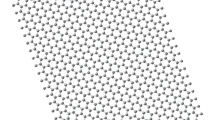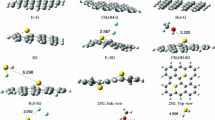Abstract
The effects of L-serine amino acid functionalization on a graphene plane were investigated through density functional theory calculations compared with those of oxygen functionalization. Three systems of 4 × 4 graphene supercells were created and functionalized by an epoxy group, a hydroxyl group, and an L-serine molecule. From the geometry optimization of the system containing a 4 × 4 graphene supercell and an L-serine molecule, it was found that a by-product hydroxyl group was formed by the dissociation of the −OH from the parental −COOH group and two covalent bonds forming at a couple of adjacent atoms on the graphene plane. The adsorption energy of the L-serine functionalization was weaker than that of the epoxy functionalization but was stronger than that of the hydroxyl functionalization. Electronic properties of this new L-serine functionalization were similar to epoxy functionalization at low functionalization density, as the Dirac cone was preserved with shifted wave vector due to the double sp3 vacancies. The C2v type of two-fold symmetry was observed through the local density of states (LDOS) and the gamma-point HOMO electron density analysis. However, the improved binding surface area of serine-functionalized graphene was observed, as four polar groups emerged from a single functionalization. Therefore, serine functionalization is a promising way to improve the properties of graphene-based electrodes.

Graphical abstract






Similar content being viewed by others
References
Novoselov KS (2004) Electric field effect in atomically thin carbon films. Science. 306:666–669. https://doi.org/10.1126/science.1102896
Geim AK, Novoselov KS (2007) The rise of graphene. Nature Mater. 6:183–191. https://doi.org/10.1038/nmat1849
Schultz BJ, Dennis RV, Lee V, Banerjee S (2014) An electronic structure perspective of graphene interfaces. Nanoscale. 6:3444. https://doi.org/10.1039/c3nr06923k
Wang X, Gao D, Li M, Li H, Li C, Wu X, Yang B (2017) CVD graphene as an electrochemical sensing platform for simultaneous detection of biomolecules. Sci. Rep. 7:7044. https://doi.org/10.1038/s41598-017-07646-2
Yang G, Li L, Lee WB, Ng MC (2018) Structure of graphene and its disorders: a review. Sci. Technol. Adv. Mater. 19:613–648. https://doi.org/10.1080/14686996.2018.1494493
Tian W, Zeng YC, Zhang ZH (2013) Electronic properties of graphene nanoribbons with periodically hexagonal nanoholes. J. Appl. Phys. 114:074307. https://doi.org/10.1063/1.4818615
Lundie M, Šljivančanin Ž, Tomić S (2015) Electronic and optical properties of reduced graphene oxide. J. Mater. Chem. C 3:7632–7641. https://doi.org/10.1039/C5TC00437C
Min BJ, Jeong HK, Lee C (2015) Plane wave density functional theory studies of the structural and the electronic properties of amino acids attached to graphene oxide via peptide bonding. J. Korean Phys. Soc. 67:507–511. https://doi.org/10.3938/jkps.67.507
Bao Y, Song J, Mao Y, Han D, Yang F, Niu L, Ivaska A (2011) Graphene oxide-Templated Polyaniline microsheets toward simultaneous electrochemical determination of AA/DA/UA. Electroanalysis. 23:878–884. https://doi.org/10.1002/elan.201000607
Chitravathi S, Swamy BEK, Mamatha GP, Sherigara BS (2011) Simultaneous electrochemical determination of dopamine and ascorbic acid using poly (l-serine) modified carbon paste electrode. J. Mol. Liq. 160:193–199. https://doi.org/10.1016/j.molliq.2011.03.019
Becke AD (2014) Perspective: Fifty years of density-functional theory in chemical physics. The Journal of Chemical Physics 140:18A301. https://doi.org/10.1063/1.4869598
Yan J-A, Chou MY (2010) Oxidation functional groups on graphene: structural and electronic properties. Phys. Rev. B 82:125403. https://doi.org/10.1103/PhysRevB.82.125403
Giannozzi P, Baroni S, Bonini N, Calandra M, Car R, Cavazzoni C, Ceresoli D, Chiarotti GL, Cococcioni M, Dabo I, Corso AD, de Gironcoli S, Fabris S, Fratesi G, Gebauer R, Gerstmann U, Gougoussis C, Kokalj A, Lazzeri M, Martin-Samos L, Marzari N, Mauri F, Mazzarello R, Paolini S, Pasquarello A, Paulatto L, Sbraccia C, Scandolo S, Sclauzero G, Seitsonen AP, Smogunov A, Umari P, Wentzcovitch RM (2009) QUANTUM ESPRESSO: a modular and open-source software project for quantum simulations of materials. J. Phys.: Condens. Matter. 21:395502. https://doi.org/10.1088/0953-8984/21/39/395502
Moon HS, Lee JH, Kwon S, Kim IT, Lee SG (2015) Mechanisms of Na adsorption on graphene and graphene oxide: density functional theory approach. Carbon Letters. 16:116–120. https://doi.org/10.5714/CL.2015.16.2.116
Song C, Wang J, Meng Z, Hu F, Jian X (2018) Density functional theory calculations of the quantum capacitance of Graphene oxide as a Supercapacitor electrode. ChemPhysChem. 19:1579–1583. https://doi.org/10.1002/cphc.201800070
Hummers WS, Offeman RE (1958) Preparation of graphitic oxide. J. Am. Chem. Soc. 80:1339–1339. https://doi.org/10.1021/ja01539a017
Sohail M, Saleem M, Ullah S, Saeed N, Afridi A, Khan M, Arif M (2017) Modified and improved Hummer’s synthesis of graphene oxide for capacitors applications. Modern Electronic Materials. 3:110–116. https://doi.org/10.1016/j.moem.2017.07.002
Taluja Y, SanthiBhushan B, Yadav S, Srivastava A (2016) Defect and functionalized graphene for supercapacitor electrodes. Superlattice. Microst. 98:306–315. https://doi.org/10.1016/j.spmi.2016.08.044
Ni J, Yang B, Jia F, She Y, Song S, Quintana M (2018) Theoretical investigation of the sensing mechanism of the pure graphene and AL,B,N,P doped mono-vacancy graphene-based methane. Chem. Phys. Lett. 710:221–225. https://doi.org/10.1016/j.cplett.2018.08.076
Funding
The authors were supported by the Thailand Center of Excellence in Physics (ThEP).
Author information
Authors and Affiliations
Corresponding author
Additional information
Publisher’s note
Springer Nature remains neutral with regard to jurisdictional claims in published maps and institutional affiliations.
Rights and permissions
About this article
Cite this article
Prasert, K., Sutthibutpong, T. Effects of L-serine amino acid functionalization on electronic properties of a graphene plane in comparison with oxygen functionalization. J Mol Model 26, 206 (2020). https://doi.org/10.1007/s00894-020-04466-6
Received:
Accepted:
Published:
DOI: https://doi.org/10.1007/s00894-020-04466-6




